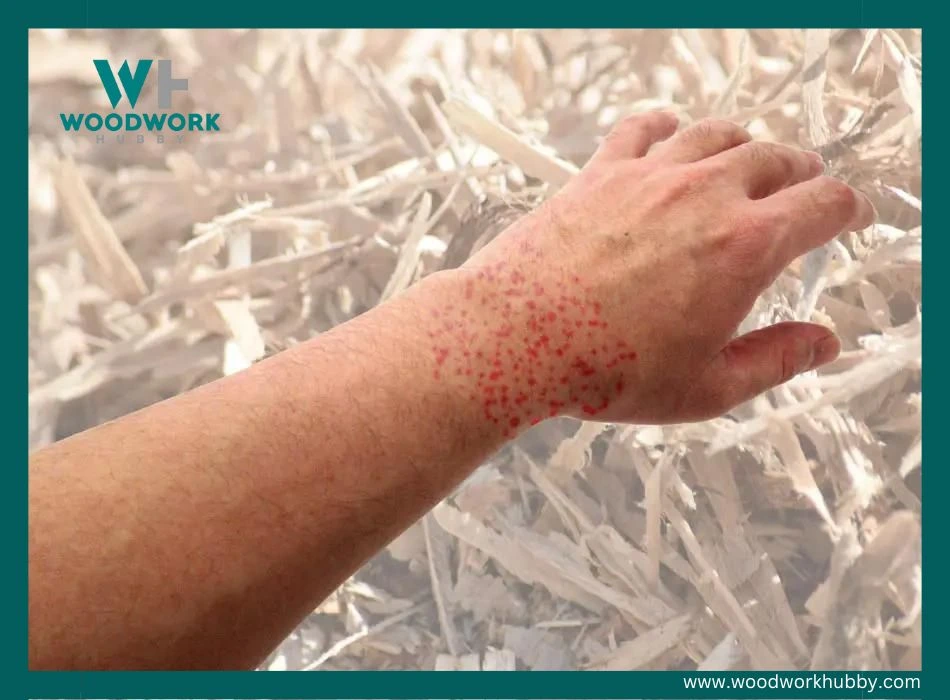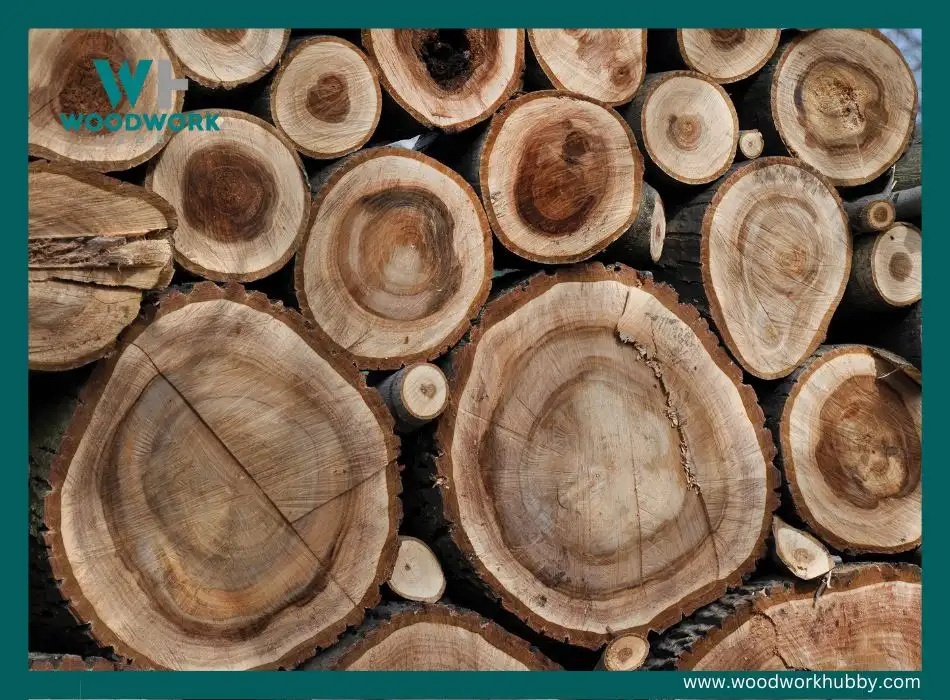Only just last week I was ripping some walnut wood for an upcoming project and my left forearm felt a little itchy afterward. I don’t normally get allergies although I have heard that Walnut wood could cause allergic reactions for some people so I decided to investigate further. Here is what I found out; can Walnut wood cause allergies?
Walnut wood could cause allergic reactions for people who generally have sensitive skin and these effects are only felt by approximately 5% of the woodworking population. Most people with walnut allergies are allergic to the protein in the nut, not the wood.
Read on as I dive deeper into this topic and tell you everything you need to know about walnut wood and walnut allergies.
Can Walnut Wood Cause An Allergic Reaction?

If you are allergic to walnuts, it is most likely that you are allergic to the protein in the nut, not the wood. While there are people with wood allergies, the chances of having an allergic reaction to walnut wood are slim.
Note that any finished walnut wood product will often be sanded and sealed multiple times. This means that there is little to no chance of you having an allergic reaction to a finished product, such as walnut furniture.
Be sure to see my full article on Is Walnut Wood Food Safe?
However, it is possible that you could have an allergic reaction to the wood dust if you are particularly sensitive. If you are working with raw walnut wood and start to experience symptoms such as sneezing, a runny nose, or watery eyes, you probably have an allergy to wood dust.
While there are contact allergies to a variety of woods, they are often occupational. This means they mostly affect the people working with the woods directly, such as carpenters, woodworkers, and furniture makers. They are, however, uncommon.
Here’s a table showing the potency and effects of walnut wood allergies:
| Walnut Tree/Wood | Potency | Most Common Effects | Area Affected |
|---|---|---|---|
| Black Walnut | 2/5 | Irritation, Sensitization, NPC (Nasopharyngeal carcinoma) in rare cases | Lungs, Eyes Skin |
| African Walnut | 3/5 | Systemic Effects, Irritation, rare NPC | Skin, Lungs, Eyes |
| English Walnut | 2/5 | Irritation, rare NPC | Skin, Lungs, Eyes |
| Poison Walnut | 4/5 | Irritation, Asthma Attacks, Giddiness, Nausea, (Its Sap is Corrosive and Toxic) | Skin, Lungs |
I must also mention that walnut trees are wind-pollinated and you could actually be allergic to the pollen from the tree. If you are allergic to other types of pollen, such as grass or trees, then there is a chance that you could be allergic to walnut tree pollen.

I have reached out to the woodworking community on Facebook and this is what my fellow woodworkers had to say.


How Common Are Walnut Allergies?
Walnut allergy is one of the most common food allergies, affecting between 0.2% and 0.5% of the population in the UK and US alone. This population includes both children and adults. Walnut allergies can start as early as infancy, but they are more common in adults. In fact, about 50% of people with walnut allergies develop them after childhood.
There is a possibility that a person with a walnut allergy may become tolerant if they avoid the allergen for some years. However, this is yet to be proven.
Walnut allergy is often associated with other tree nut allergies, such as hazelnut, almond, and Brazil nut allergies. This is because these nuts share a similar protein structure. In fact, about 30% of people with a walnut allergy are also allergic to one or more other types of tree nuts.
Can You Be Allergic To Black Walnut Wood?
While there is a possibility that you could have an allergic reaction to black walnut wood, it is very unlikely. You are more likely to be allergic to the black walnut itself and not the wood.
The black walnut is a type of tree nut that is related to the more common English walnut. Both nuts contain a protein that can cause an allergic reaction in some people. So, if you are allergic to one, there is a chance you could be allergic to the other.
Unless you are chewing on the black walnut twigs and branches or you inhale the wood dust, you should be just fine touching or working with black walnut wood.
What Are The Symptoms Of a Walnut Allergy?
There are many different symptoms of an allergy the most common ones being sneezing, runny nose, watery eyes, coughing, wheezing, and in severe cases, anaphylaxis.
Take a look at this video which outlines the common symptoms:
Video showing symptoms of an allergy
Before I take a deeper look at a few of them, it is important to mention that every person has a different reaction to an allergen. So the way your immune system reacts to a walnut allergen may be different from the way someone else’s does.
The Most Common Symptoms Of An Allergy Are:
Nasal Congestion and Runny Nose
Most people with a walnut allergy will experience nasal congestion and a runny nose. This is because the allergen irritates the mucous membranes in your nose.
Sneezing
Another symptom of a walnut allergy is sneezing. This is also caused by the allergen irritating the mucous membranes in your nose. If you have a walnut allergy, you may find that you sneeze more often than usual when you are around the allergen.
Itchy Eyes and Watery Eyes
Another common symptom of an allergy is itchy eyes and watery eyes. This is caused by the allergen irritating the conjunctiva, which is the thin membrane that covers your eyeball.
Itchy Throat and Hoarseness
You may also experience an itchy throat and hoarseness. This is caused by the allergen irritating the lining of your throat. If you have a walnut allergy, you may find that your throat feels scratchy and you may have trouble speaking.
Coughing and Wheezing
While not as common, some people with a walnut allergy may also experience coughing and wheezing. This is caused by the allergen irritating the airways.
Shortness of Breath
In severe cases, a person with a walnut allergy may experience shortness of breath. This is caused by the allergen causing the muscles around the airways to tighten.
Anaphylaxis
In very rare cases, a person with a walnut allergy may experience anaphylaxis. This is a severe and potentially life-threatening reaction that can cause trouble breathing, swelling of the throat, and low blood pressure. If you have any of these symptoms, it is important to seek medical help immediately.
Other walnut allergy symptoms include:
- Hives
- Eczema
- Itchy skin
- Tingling in the mouth
- Nausea and vomiting
- Diarrhea
- Headache
- Dizziness

I must mention again that these symptoms appear differently depending on the person. Some people experience multiple symptoms while others only experience one or two. And the severity of the symptoms also varies from person to person.
If you think you may have a walnut allergy, it is important to see an allergist for testing. They will be able to determine if you are allergic and what your reaction is like. From there, they can develop a treatment plan that is right for you.
Can People With Nut Allergies Touch Walnut Wood?
It is unlikely that people with a nut allergy will have a reaction to touching or working with walnut wood. This is because the allergen that causes the reaction is found in the nut itself and not the wood.
I have seen people with nut allergies work with walnut wood without any problems. However, if you are concerned about it, you can always wear gloves or a mask to avoid contact with the wood.
Is Walnut Tree Dust Toxic?
Walnut tree dust is toxic as it contains a chemical substance called juglone especially prevalent in Black Walnut. Juglone is a known irritant and can cause skin rashes, eye irritation, and respiratory problems. Care needs to be taken when being exposed to Walnut tree dust.

If you have a nut allergy, it is important to avoid inhaling walnut tree dust. If you must work with the dust, be sure to wear a mask or respirator to protect your lungs.
Video on Toxic wood
Are Tree Nut Allergies The Same As Wood Allergies?
Tree nut allergies are not the same as wood allergies. An allergy to tree nuts is a reaction to the proteins/allergens found in the nut itself. A wood allergy is a reaction to the proteins/chemicals found in the tree/wood.
With a tree nut allergy, you may have a reaction if you eat the nut or come into contact with it. With a wood allergy, you may have a reaction if you touch the wood or inhale the dust.
Wood allergies are not as common as tree nut allergies. However, they can be just as severe. If you have a wood allergy, it is important to avoid contact with the allergen and seek medical help if you have a reaction.
Tree nut allergies, on the other hand, are more common. If you have a tree nut allergy, you need to be careful of the foods you eat and avoid contact with nuts.
Are People With a Walnut Allergy Allergic To Walnut Wood?
Not all people with a walnut allergy are allergic to walnut wood. The allergen that causes the reaction is found in the nut. As the wood does not have the same protein or as much protein, not everyone with a walnut allergy will have a reaction to it.
However, some people may have a cross-reaction to the proteins in the wood. This means that they may have a reaction if they come into contact with it. If you are concerned about a reaction, it is best to avoid contact with the wood.
Can You Get a Rash From Walnut Wood?
If you are allergic to juglone, which is prevalent in black walnut wood, you may develop a rash from working with it. Juglone is a known irritant and can cause skin rashes, eye irritation, and respiratory problems.
If you have a black walnut allergy or are concerned about developing an allergy, it is best to avoid contact with the wood. I mentioned earlier about occupational allergies. This is when people who work with certain materials develop an allergy to them. One example of this is woodworkers.
Video showing allergies
How is a Walnut Allergy Diagnosed?
You will need to visit an allergist to get diagnosed. They will likely ask you a few questions about your symptoms and when they occur. They may also ask about your family history of allergies. After that, they will likely do some tests which include blood and skin prick tests.
A skin prick test
A skin prick test involves putting a small amount of the allergens on your skin and then making a small prick in the skin. If you are allergic, you will develop a raised, red bump within 15 minutes.
A blood test
A blood test can measure your immune system’s response to the allergen. This is done by taking a sample of your blood and then measuring the amount of antibodies present.
Once you have been diagnosed with a walnut allergy, your allergist will likely recommend avoiding exposure to the allergen. They may also prescribe you an emergency epinephrine injection in case you have a severe reaction.
How to Avoid Walnut Wood Allergic Reactions
If you are sure you are allergic to walnut wood, the best way to avoid a reaction is to stay away from it. This means avoiding contact with the wood and not being around people who are working with it.
If you must be around the wood, there are some things you can do to protect yourself:
Wear a dust mask or respirator
If you are going to be around the wood, make sure to wear a dust mask or respirator. This will help to filter out the allergens and prevent you from inhaling them.
Wear gloves and long sleeves
If you are going to be working with the wood, make sure to wear gloves and long sleeves. This will help to protect your skin from coming into contact with the allergen.
Take an antihistamine
If you are going to be around the wood, you may want to take an antihistamine beforehand. This will help to reduce your symptoms if you do have a reaction.
Is It Possible To Outgrow Walnut Allergens?
An allergy is often a lifelong condition. While there is a small possibility that people suffering from allergies can outgrow them, it is more likely that the allergy will persist into adulthood. If you have a walnut allergy, it is best to avoid exposure to the allergen and be prepared for a reaction if you do come into contact with it.
Final Thoughts – Can Walnut Wood Cause Allergies?
Walnut allergies are some of the most common food allergies in children and adults. While walnut wood allergy is rare, some people may have a cross-reaction to the proteins in the wood. If you are concerned about a reaction, it is best to avoid contact with the wood.
I hope this article has helped you to understand more about walnut wood allergies and how to avoid them. If you have any questions, please feel free to leave a comment below and I will do my best to answer them.



